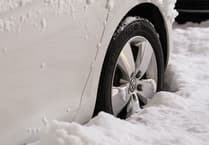WITH the warmer weather coming, we’ll once again be jumping in our cars and heading out for day trips to explore the country. But with the warmer weather comes potential vehicle damage.
Along with warm sun and longer days, the spring and summer also brings added hazards for our motors. Believe it or not, trees and animals can cause permanent damage to your car’s paintwork that is generally only repairable by footing a bill which can be up to four figures.
To help you avoid irreversible damage, uswitch, the price comparison service and switching website, looked at the most common issues caused by nature and given you some tips and tricks on how to protect your car as you start venturing outside.
Tree sap
Tree sap generally starts to fall in the spring and continues well into the summer. It’s a thick, sticky liquid that is harvested to make food and objects, such as maple syrup and glue. Although it can be incredibly useful in day-to-day life, it can also become a big problem for car owners – especially as temperatures start to creep up.
If tree sap gets onto your paintwork, it can begin to eat through the wax and clear coat finish that sits on top of the coloured paint, leaving behind permanent blemishes which could then reduce the value of your car when you come to sell it.
The key to removing tree sap and minimising damage is to act as fast as you can. Of course, it’s difficult when you’re out and about, but if you have some water and a cloth, you can remove the excess while you’re not at home, before giving the area a good clean with car shampoo when you’re able.
If you’ve found the sap has hardened over a longer period of time, or has been in direct sunlight for many hours, don’t worry – there are still things you can do. Sap remover is great for breaking down the hardened liquid, meaning you can wipe it away without the need for vigorous scrubbing.
You can also buy clay bars for stubborn sap stains. These are designed to be used after a thorough car clean and remove any remaining sap on your car.
Bird poo
Arguably the most common blight when it comes to our cars is finding bird poo on our roofs, doors and bonnets. An issue all year-round, it can be more common in spring and summer as birds hunt to feed their chicks and they then begin to flee the nest.
It may be classed as lucky, but bird poo is anything but for cars. Extremely acidic, it cuts through paintwork if left to set. At certain times of the year you may also find digested berries in the poo, which can make it more difficult to remove.
If you catch bird poo while it’s still wet, you can usually wipe it off with a soft, damp cloth and some water. However, once it’s dry, it can be more difficult to remove.
Start by getting off the excess with a damp cloth, before using a car shampoo and water to softly buff off the excess. If you don’t have any car shampoo, a handy alternative is sparkling water – just soak a cloth in the water and let it sit on the offending area for a few minutes before wiping it away.
Blossom
It may look lovely, but tree blossom can cause havoc with car bodywork once stuck on. The delicate blossoms bloom in early spring and start to fall as we head into the summer. If left on your car for too long they will stick to the paintwork and become increasingly difficult to remove.
How to remove tree blossom from your car
Should you notice blossom has fallen onto your car, the first thing you should do is try and remove them with your hands and rinse the area. This works if they’ve recently fallen in dry weather, but if they’re wet, you’ll have to use water to wash them off. If you find they’re stuck to your paintwork, the best thing to do is shampoo the area to completely remove any trace.




